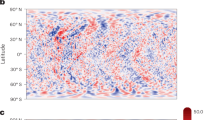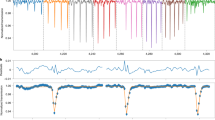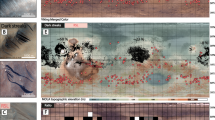Abstract
Mars has an active surface, with omnipresent small dust particles and larger debris. With an ambient pressure below 10 mbar, which is less than 1% of the surface pressure on Earth, its CO2 atmosphere is rather tenuous. Aeolian processes on the surface such as drifting dunes, dust storms and dust devils are nevertheless still active1,2,3. The transport of volatiles below the surface, that is, through the porous soil, is unseen but needs to be known for balancing mass flows4,5. Here, we describe a mechanism of forced convection within porous soils. At an average ambient gas pressure of 6 mbar, gas flow through the porous ground of Mars by thermal creep is possible and the soil acts as a (Knudsen) pump. Temperature gradients provided by local and temporal variations in solar insolation lead to systematic gas flows. Our measurements show that the flow rates can outnumber diffusion rates. Mars is the only body in the Solar System on which this can occur naturally. Our laboratory experiments reveal that the surface of Mars is efficient in cycling gas through layers at least centimetres above and below the soil with a turnover time of only seconds to minutes.
This is a preview of subscription content, access via your institution
Access options
Subscribe to this journal
Receive 12 print issues and online access
$259.00 per year
only $21.58 per issue
Buy this article
- Purchase on SpringerLink
- Instant access to full article PDF
Prices may be subject to local taxes which are calculated during checkout





Similar content being viewed by others
References
Greeley, R., Lancaster, N., Lee, S. & Thomas, P. Mars 730–766 (Univ. Arizona Press, 1992).
Bridges, N. et al. Earthlike sand fluxes on Mars. Nature 485, 339–342 (2012).
Reiss, D., Zanetti, M. & Neukum, G. Multitemporal observations of identical active dust devils on Mars with the high resolution stereo camera (HRSC) and Mars orbiter camera (MOC). Icarus 215, 358–369 (2011).
Sizemore, H. G. & Mellon, M. T. Laboratory characterization of the structural properties controlling dynamical gas transport in Mars-analog soils. Icarus 197, 606–620 (2008).
Bryson, K. L., Chevrier, V., Sears, D. W. G. & Ulrich, R. Stability of ice on Mars and the water vapor diurnal cycle: Experimental study of the sublimation of ice through a fine-grained basaltic regolith. Icarus 196, 446–458 (2008).
Kieffer, H. H., Jakosky, B. M. & Snyder, C. W. Mars 1–33 (Univ. Arizona Press, 1992).
Dollfus, A. & Deschamps, M. Grain size determination at the surface of Mars. Icarus 67, 37–50 (1986).
Knudsen, M. Eine Revision der Gleichgewichtsbedingung der Gase. Thermische Molekularströmung. Ann. Phys. 336, 205–229 (1909).
Muntz, E. P., Sone, Y., Aoki, K., Vargo, S. & Young, M. Performance analysis and optimization considerations for a Knudsen compressor in transitional flow. J. Vac. Sci. Technol. 20, 214–224 (2002).
Kelling, T. & Wurm, G. Self-sustained levitation of dust aggregate ensembles by temperature-gradient-induced overpressures. Phys. Rev. Lett. 103, 215502 (2009).
Han, Y. L. Investigation of Micro/Meso-scale Knudsen Compressors at Low Pressures (ProQuest Information and Learning Company, 2006).
Hudson, T. L. et al. Water vapor diffusion in Mars subsurface environments. J. Geophys. Res. 112, E05016 (2007).
Mellon, M. & Jakosky, B. Geographic variations in the thermal and diffusive stability of ground ice on Mars. J. Geophys. Res. 98, 3345–3364 (1993).
Wurm, G. & Krauss, O. Dust eruptions by photophoresis and solid state greenhouse effects. Phys. Rev. Lett. 96, 134301 (2006).
Kelling, T. & Wurm, G. A mechanism to produce the small dust observed in protoplanetary disks. Astrophys. J. 733, 120–124 (2011).
de Beule, C., Kelling, T., Wurm, G., Teiser, J. & Jankowski, T. From planetesimals to dust: Low-gravity experiments on recycling solids at the inner edges of protoplanetary disks. Astrophys. J. 763, 11 (2013).
Kocifaj, M., Klačka, J., Kelling, T. & Wurm, G. Radiative cooling within illuminated layers of dust on (pre)-planetary surfaces and its effect on dust ejection. Icarus 211, 832–838 (2011).
Presley, M. A. & Christensen, P. R. Thermal conductivity measurements of particulate materials. J. Geophys. Res. 102, 6535–6549 (1997).
Chapman, S. & Cowling, T. in The Mathematical Theory of Non-Uniform Gases 3 edn 288 (Cambridge Univ. Press, 1970).
Squyres, S. W., Clifford, S. M., Kuzmin, R. O., Zimbelman, J. R. & Costard, F. M. Mars 523–554 (Univ. Arizona Press, 1992).
Hudson, T. L. & Aharonson, O. Diffusion barriers at Mars surface conditions: Salt crusts, particle size mixtures, and dust. J. Geophys. Res. 113, E09008 (2008).
McSween, H. Y. Jr & Keil, K. Mixing relationships in the Martian regolith and the composition of globally homogeneous dust. Geochim. Cosmochim. Acta 64, 2155–2166 (2000).
Krömle, N. I., Dettleff, G. & Dankert, C. Thermal behavior of pure and dusty ices on comets and icy satellites. Astron. Astrophys. 227, 246–254 (1990).
Wurm, G. Light-induced disassembly of dusty bodies in inner protoplanetary discs: Implications for the formation of planets. Mon. Not. R. Astronom. Soc. 380, 683–690 (2007).
Jankowski, T. et al. Crossing barriers in planetesimal formation: The growth of mm-dust aggregates with large constituent grains. Astron. Astrophys. 542, A80 (2012).
Acknowledgements
This project is supported by DLR Space Management with funds provided by the Federal Ministry of Economics and Technology (BMWi) under grant number DLR 50 WM 1242. T.J. and M.K. are supported by the DFG. Access to earlier microgravity experiments on parabolic flights leading to the development of the experiment was granted by DLR and ESA.
Author information
Authors and Affiliations
Contributions
C.d.B. and J.T. designed the experiment. C.d.B. performed the experiment with help from G.W., T.K., M.K., T.J. and J.T. M.K. simulated the gas flow with help from G.W. C.d.B. and G.W. wrote the paper with input from T.K., M.K., T.J. and J.T.
Corresponding author
Ethics declarations
Competing interests
The authors declare no competing financial interests.
Rights and permissions
About this article
Cite this article
de Beule, C., Wurm, G., Kelling, T. et al. The martian soil as a planetary gas pump. Nature Phys 10, 17–20 (2014). https://doi.org/10.1038/nphys2821
Received:
Accepted:
Published:
Issue date:
DOI: https://doi.org/10.1038/nphys2821
This article is cited by
-
Understanding planet formation using microgravity experiments
Nature Reviews Physics (2021)
-
Knudsen pumps: a review
Microsystems & Nanoengineering (2020)
-
Formation of recurring slope lineae on Mars by rarefied gas-triggered granular flows
Nature Geoscience (2017)
-
Gas flow within Martian soil: experiments on granular Knudsen compressors
Astrophysics and Space Science (2017)
-
Tracing Thermal Creep Through Granular Media
Microgravity Science and Technology (2017)



